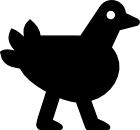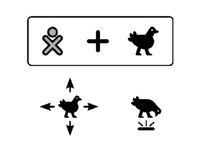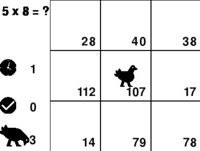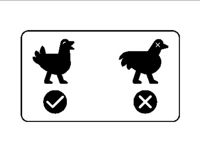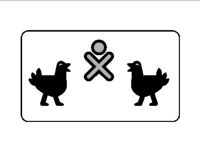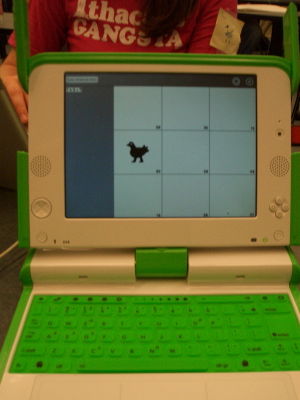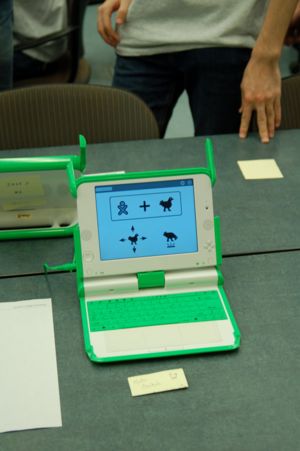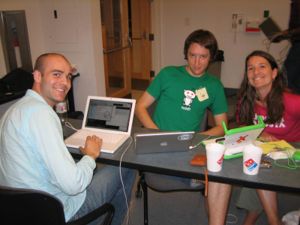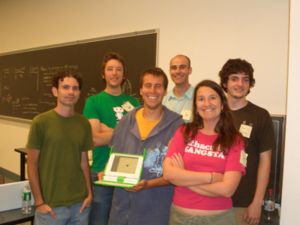Kuku
| Kuku | |
| Status: | In Development/XO Testing |
| Version: | 0.1 |
| Base: | 0.1 |
| Source: | Trac tickets |
| l10n: | Kuku/Localization |
| Contributors | |
| Julius B. Lucks, Adrian DelMaestro, Sera L. Young, Roberto Christen, Matthew Myers, Brian Jordan | |
Description & Goals
Summary
Kuku, short for 'Kuku Anakula' (Hungry Chicken), is based on the basic arithmetic education game Number Munchers. In single player mode, the game consists of a simple grid that the player (a chicken) is allowed to move around on. A question is posed outside of the grid, such as '5 + 5 = ?', and each square in the grid has a potential answer in it. The goal is to 'eat' as many correct answers as possible within a given time frame to accumulate points. There are penalties for eating incorrect answers, and the questions are changed when all correct answers are eaten. As the game progresses, the questions become more difficult. In multiplayer mode, the grid will be able to expand with multiple chickens that can compete against each other, or work as a team to eat all the correct answers.
We imagine this game to be one instance that relies on a more general question-answer, or quiz library. The idea is that all of the questions and answers will be stored and editable by kids and teachers. Question content is not restricted to basic arithmetic, but can consist of multiple choice questions, vocabulary questions, image recognition questions, and many more. Specific examples might consist of:
- a fill in the blank sentence as the question with multiple vocabulary words as the answers
- a snapshot of a tree taken by the child as the question with names of types of trees as the answers
- an arithmetic expression as the question with numbers as the answers
In order to develop this game then, we would like to develop a simple question and answer library that teachers can use to port their existing materials for the game. The game can then be considered as a study tool for children for an upcoming test, and we imagine that the same library will be useful in a testing activity which actually conducts the test on the laptops.
We also think that the structure of this game will get kids interested in developing their own content or versions of the game. Having questions and answers in easily editable files will introduce children to poking around the internals, and we hope to design the game code in such a way as to naturally lead the children into learning about programming and tweaking the game themselves. This might be done through the quiz library using programming expressions to generate incorrect, 'red herring', answers for seeding the grid.
We greatly appreciate discussion, especially on the design of the question/answer library (see below).
Goals
- To develop a general question/answer library that teachers can use to port existing quiz material for use in this game and other activities.
- To develop a Number Munchers-like game activity that enables children to be quizzed on a variety of educational topics in a fun way
- To emphasize the fact that both the content and the game itself can be changed through project structure as well as hints to the children in the activity that this can be done.
Collaboration
- We hope to create a multiplayer mode that allows several players (communicating through the mesh) to be able to play on the same grid in either competition or cooperation mode.
We Need Your Help!
Right now the Kuku code runs, but it is in an awful state! We would love feedback and help in the following areas:
- game design and flow: any ideas about how to make the game more interesting and challenging for the kids
- interfacing with educators: feedback on the best way to make the game content adjustable by educators
- internationalization!: we need to get this effort going
- testing: see our testers page for instructions on downloading and testing Kuku.
Please contact us if you would like to help out.
Question format
Questions and answers are effectively equivalence classes. In the most abstract rendition, a question/answer pair could be any two elements drawn from an equivalence class; the player would have to figure out the equivalence (or have a hint from the context of that level) and choose the best match. Making a board for these equivalences would require having a sufficiently large pool of possible answers, a way of randomly selecting entries from the available pool, including at least one equivalent item, and a way to determine equivalence.
Example: numbers and equations
- The equivalence class could consist of the equation, and the set of all numbers which on evaluation satisfy it. One could simply store equations and, when generating the board, be sure to generate at least one number by plugging an integer into the equation.
- In question: when is equivalence tested? When the board is seeded or when an answer is selected? Right now this happens when the answer is selected.
Example: numbers and images
- The equivalence class could also consist of a key (for the class), a primary element in the equivalence class (a canonical 'question' for many answers, if one exists), and a set of equivalent entries.
- For instance: "one" [the key], an image string for an image of the numeral 1, and images of 1 piece of various fruits and other objects. the images would all be thumbnailed to the same small size. This could work with the current memory number game, for instance.
Visual Design
Screenshots
We want to make the game images as 'discoverable' as possible. To that end, the start screen describes the nature of the game (addition symbol for mathematics (right now)), the arrow keys denote chicken motion, and the B2 space-bar key tells the kids how to make the chicken peck. There are a lot of numbers or the game screen which could certainly be dealt with better. The losing and winning screens are added to by downbeat and upbeat music, respectively.
XO Screenshots
This screenshot depicts the basic grid layout with the player (chicken) in the lower left-hand corner. The question (5 + 5 = ?) is posed outside the upper left of the grid. Below the question are the current score (+25), and the current time (1.35 s). (Please excuse the state of this screenshot - we have not focused on the graphics yet!)
This screenshot shows the startpage of the version of the activity that was judged by children on Sunday afternoon during the first OLPC Game Jam.
Development
Source
The code is just python and pyGame. The code can be checked out and dropped into a directory called Kuku.activity and placed in a Sugar activities directory to be able to work on an XO.
Activity Source: http://dev.laptop.org/git.do?p=projects/kuku
git clone git://dev.laptop.org/projects/kuku
Activity xo bundle (un-zip with unzip kuku.xo): http://dev.laptop.org/~lucks/kuku.xo
curl -C - -O http://dev.laptop.org/~lucks/kuku.xo
Git Usage
Please look at our git usage page for instructions on how to work with our branching structure.
Implementation Discussion
Version History
Localization
People
Adrian, Julius and Sera hacking away at the Boston 2007 Game Jam.
Team Kuku after the first night of the Game Jam at Olin College, with kuku running: Roberto, Julius, Matt, Adrian, Sera, Brian.
- Julius Lucks (lucks on #sugar and #olpc-content IRC)
- Adrian DelMaestro
- Sera Young sly3 (at) cornell (dot) edu
- Roberto Christen (roberto (dot) christen (at) gmail (dot) com)
- Matthew Myers matt (at) 2eastmusic (dot) com
- Brian Jordan bjordan (at) wesleyan (dot)edu
Question/Answer Library
We have started to sketch some API designs. So far I have outlined a basic QA class that is responsible for managing the question and answers (both correct and incorrect) for a single question.
from QA import QA
#Basic question/answer
q = QA()
#Load question/correct answer/false answers
q.set_question('5 + 5')
q.set_correct_answer(10)
q.set_false_answer(9)
q.set_false_answer([9,11])
import random
false_function = lambda x: random.randint(*random.choice([(0,x-1),(x+1,50)]))
q.set_false_function(false_function)
#Get question and answers
q.get_question()
'5 + 5'
q.get_correct_answer()
10
q.get_false_answer()
9
11
21
3
I have written some unit tests for the above functionality that I will put into the git repo once it is set up.
The next step is to define a syntax for a textfile that can be parsed and questions loaded from. With a set of questions loaded, it should be very simple to create a command-line quiz activity.
Something light weight like this will be all that Kuku needs, and will be simple for children to work from. We would love feedback on this though, especially if you have other activities that would benefit from such a general question/answer library.
Resources
- A web version of the original Number Munchers game (Firefox on Windows only).
- A down loadable version of the original Number Munchers game.
- Number munchers on Wikipedia
- Lincolnquirks git version of olpcgames git://dev.laptop.org/projects/games-misc
Useful Links
Educational_activity_guidelines
